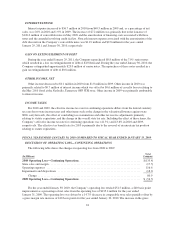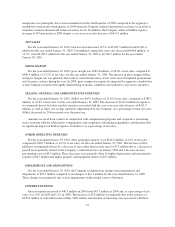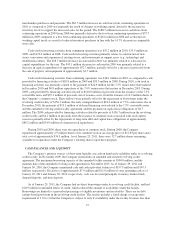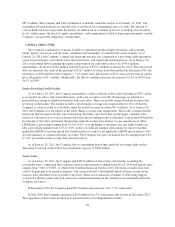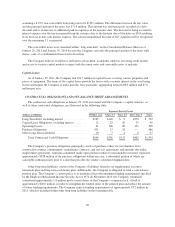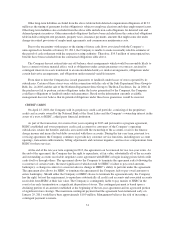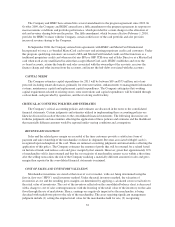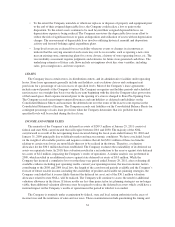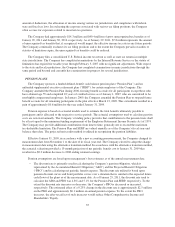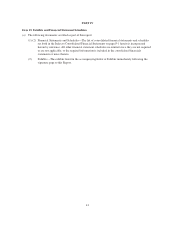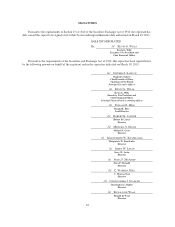Saks Fifth Avenue 2010 Annual Report Download - page 33
Download and view the complete annual report
Please find page 33 of the 2010 Saks Fifth Avenue annual report below. You can navigate through the pages in the report by either clicking on the pages listed below, or by using the keyword search tool below to find specific information within the annual report.The Company and HSBC have entered into several amendments to the program agreement since 2003. In
October 2009, the Company and HSBC entered into a fifth amendment to the program agreement in response to
macroeconomic conditions and portfolio performance, which provided for certain changes to the allocation of
risk and revenue sharing between the parties. The fifth amendment, which became effective February 1, 2010,
provides for HSBC to share with the Company certain credit losses of the card portfolio and also provides
increased revenue sharing to the Company.
In September 2006, the Company entered into agreements with HSBC and MasterCard International
Incorporated to issue a co-branded MasterCard card to new and existing proprietary credit card customers. Under
this program, qualifying customers are issued a SFA and MasterCard-branded credit card that functions as a
traditional proprietary credit card when used at any SFA or OFF 5TH store and at Saks Direct or as a MasterCard
card when used at any unaffiliated location that accepts MasterCard cards. HSBC establishes and owns the
co-brand accounts, retains the benefits and sales associated with the ownership of the accounts, receives the
finance charge and other income from the accounts, and incurs the bad-debts associated with the accounts.
CAPITAL NEEDS
The Company estimates capital expenditures for 2011 will be between $65 and $75 million, net of any
proceeds including tenant allowances, primarily for store renovations, enhancements to management information
systems, maintenance capital and replacement capital expenditures. The Company anticipates that working
capital requirements related to existing stores, store renovations and capital expenditures will be funded through
cash on hand, cash provided by operations, and the revolving credit facility.
CRITICAL ACCOUNTING POLICIES AND ESTIMATES
The Company’s critical accounting policies and estimates are discussed in the notes to the consolidated
financial statements. Certain judgments and estimates utilized in implementing these accounting policies are
likewise discussed in each of the notes to the consolidated financial statements. The following discussion sets
forth the judgments and uncertainties affecting the application of these policies and estimates and the likelihood
that materially different amounts would be reported under varying conditions and assumptions.
REVENUE RECOGNITION
Sales and the related gross margin are recorded at the time customers provide a satisfactory form of
payment and take ownership of the merchandise or direct its shipment. Revenue associated with gift cards is
recognized upon redemption of the card. There are minimal accounting judgments and uncertainties affecting the
application of this policy. The Company estimates the amount of goods that will be returned for a refund based
on historical trends and reduces sales and gross margin by that amount. However, given that approximately 22%
of merchandise sold is later returned and that the vast majority of merchandise returns occur within a short time
after the selling transaction, the risk of the Company realizing a materially different amount for sales and gross
margin than reported in the consolidated financial statements is minimal.
COST OF SALES AND INVENTORY VALUATION
Merchandise inventories are stated at the lower of cost or market, with cost being determined using the
first-in, first-out (“FIFO”) retail inventory method. Under the retail inventory method, the valuation of
inventories at cost and the resulting gross margins are determined by applying a calculated cost-to-retail ratio to
the retail value of inventories. The cost of the inventory reflected on the consolidated balance sheet is decreased
with a charge to cost of sales contemporaneous with the lowering of the retail value of the inventory on the sales
floor through the use of markdowns. Hence, earnings are negatively impacted as the merchandise is being
devalued with markdowns prior to the sale of the merchandise. The areas requiring significant management
judgment include (1) setting the original retail value for the merchandise held for sale, (2) recognizing
32




